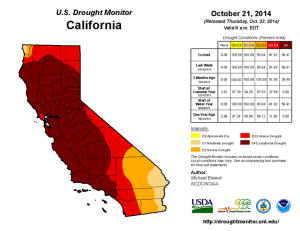By Marisa Sanchez, Molecular and Cellular Biology, ’15
The most current drought in California is considered to be one of the worst droughts in the past century, and many wonder if this severity is due to climate change. However, California has had a long history of unpredictable weather fluctuations, and is familiar with severe droughts. Many droughts can have devastating effects, particularly in the agricultural industry and the hydropower industry. Most Californians have also experienced the effects of a drought first-hand, such as having enforced water rationing. Even though, California’s history has shown that most droughts have devastating effects, droughts can also great learning experiences.
The 1976-1977 drought was one of the lowest precipitation periods in California’s history, but it was also a valuable learning experience,especially for the agricultural industry. During the 1976-1977 drought, statewide precipitation was ranked among the five lowest in California’s recorded history (Swain). The 1976-1977 drought consisted of two years with very little precipitation, while the current drought consists of a moderately dry year, 2012, and one extremely dry year, 2013; so far 2014 has been extremely dry as well.
The 1976-1977 drought is most notable for the effect it had on California’s agricultural industry. The agricultural industry experienced a huge loss due to severe water shortage in 1976-1977, and currently it is experiencing another huge loss due to the current drought (Kotin, 2014). Californians were greatly influenced by the 1976-1977 drought to conserve more water, especially in the agricultural industry (Kotin, 2014). Since that particular drought, many water-saving innovations have been made in the agricultural industry, including drip irrigation. Drip irrigation became standard practice in the agricultural industry after the 1976-1977 drought because it both conserves water and saves money (Kotin, 2014).
Another significant drought in California was, the 2007-2009 drought, which is one of the driest three-year periods in California’s recorded history. However, the 2007-2009 drought did not have a severe impact on the agricultural industry compared to the 1976-1977 drought or the current drought, because farmers were able to cope better with the reduction in water availability. Farmers were able to rely more on local groundwater, temporary water transfers (diverting water from one area with more water to an area where there is a shortage), changing types of crops, usually to crops that require less water, and changing cropping patterns, only keeping long-term crops (Christian-Smith, p.7). As a result of farmer’s resilience, several crops, such as almonds, lettuce, and tomatoes, even had record annual levels of production (Christian-Smith, p.30).
The impact of the 2007-2009 drought on agriculture may have not been severe, but the drought’s impact on hydropower production was significant; the current drought has resulted in a significant loss of hydropower as well. California hydropower production was nearly halved during the 2007-2009 drought, and within this three-year period lost hydropower was made up by the purchase and combustion of natural gas, which cost electricity ratepayers an additional $1.7 billion (Christian-Smith, p.9). Also, this combustion of natural gas resulted in the emission of an additional 13 million tons of CO2 into the atmosphere (Christian-Smith, p.85). The 2007-2009 drought highlighted the fact that many of the coping strategies used for short-term relief will not work in the long run. This gives rise to the importance of long-term water transfer programs and systems for monitoring and evaluating those transfers need to be established. Energy conservation and efficiency programs need to be expanded as well (Christian-Smith, p.86).
There is no telling how long the current drought could last, which means that developing long-term strategies to cope with the drought are of the utmost importance. The cumulative reservoir shortages of 1977 were the worst in California’s recorded history and there is five million acre-feet more water today than in 1977, however, there were millions fewer people, which means that the current population is experiencing the effects of the drought more severely, such as having to ration water even more per person (Water Conditions, 2014).
So far, 2013 has been one of the driest years in recorded history for many areas of California. Scientists have found that atmospheric conditions associated with the current drought in California are very likely linked to human-caused climate change (Explaining, p. S11). Using a combination of computer simulations and statistical techniques, scientists showed that a region of high atmospheric pressure hovering over the Pacific Ocean, which diverts storms away from California, is much more likely to form in the presence of modern greenhouse gas concentrations (Explaining, S9). If the current drought is truly a consequence of human-induced climate change, California needs to prepare for possibility of more severe droughts to come in the future.

Status of drought in California, October 21, 2014. From the National Drought Monitor map archive, http://droughtmonitor.unl.edu/MapsAndData/MapArchive.aspx
Author Michael Brewer, NCDC/NOAA
Droughts are not uncommon in California, as shown by much of California’s history, and most of California’s droughts had very negative impacts, but these droughts also became great learning experiences for Californians. In the 1976-1977 drought the agricultural industry suffered greatly and in the 2007-2009 drought, hydropower production decreased significantly. The 1976-1977 drought resulted in many new water-saving innovations made by the agriculture industry, and the 2007-2009 drought brought about the idea that long-term strategies for coping with droughts need to be designed. Hopefully the current drought will result in another learning experience for California, but more importantly hopefully there will be relief this winter from this exceptional drought.
References
Christian-Smith, Juliet, Morgan C. Levy, and Peter H. Gleick. “Impacts of the California Drought from 2007 to 2009.” Pacific Institute (2011): N.p. Web.
“Explaining Extreme Events of 2012 from a Climate Perspective.” Bulletin of the American
Meteorological Society 94.9 (2014): S1-S74. Web.
Kotin, Adam, and Dru Marion. “A History of Drought in California: Learning From the Past, Looking to the Future | Civil Eats.” Civil Eats. (2014): N.p. Web.
Swain, Daniel. “A Comparison of California’s Extreme 2013 Dry Spell to the 1976-1977 Drought.” California Weather Blog. (2013): N.p. Web.
“Water Conditions.” Water Conditions. (2014): N.p. Web. <http://www.water.ca.gov/waterconditions/>.

